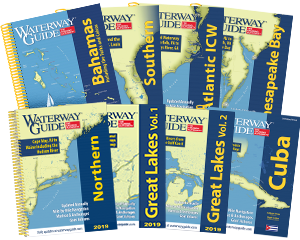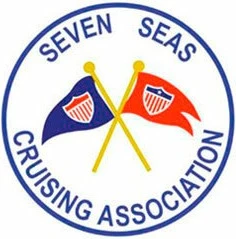Editor's Note: This column is part of a partnership between Waterway Guide Media and the US Coast Guard Auxiliary. Commodore Vincent Pica, First District, Southern Region (D1SR) United States Coast Guard Auxiliary provides our readers with his valuable insights on a regular basis.

This column is, like last week’s, a twofer. Rule 34 is about what are the proper maneuvering and warning signals – how to communicate in the absence of radio or voice signals. Rule 33 is what equipment specifications are necessary to send those signals in a consistent way. I am going to emphasize the Inland aspects of these Rules – for obvious reasons.
What Does Rule 34 Say?
Rule 34, Section A-i, says: “When power-driven vessels are in sight of one another and meeting or crossing at a distance within half a mile of each other, each vessel underway when maneuvering as authorized or required by these Rules shall indicate that maneuver by the following signals on her whistle:
- one short blast to mean ‘I intend to leave you on my port side’;
- two short blasts to mean ‘I intend to leave you on my starboard side’;
- three short blasts to mean ‘I am operating astern propulsion’.”
Section A-ii goes on to say that the opposing vessel is either to return the same signal (safe to proceed) or issue the danger signal, i.e., 5 short blasts (No go! Danger ahead for YOU!) This is the essence between the International Rules – which require no response from the opposing vessel (unless danger is ahead) – and the Inland Rules which seek to ensure that the opposing vessel understands your signal. Given the close quarters of Inland conditions, you can readily understand the seamanship reasons for this double-check. Rule 34, Section B, goes on to say that you can supplement your whistle signals with corresponding light signals.
Rule 34, Section C-i, says: When in sight of one another, a power-driven vessel intending to overtake another power-driven vessel shall indicate her intention by the following signals on her whistle:
- one short blast to mean ‘I intend to overtake you on your starboard side’;
- two short blasts to mean ‘I intend to overtake you on your port side’.”
Section C-ii, like A-ii, goes on to say that the power-driven vessel about to be overtaken shall, if in agreement, sound a similar signal. If in doubt she shall sound the danger signal.
Rule 34, Section E, requires that a vessel nearing a bend or an area of a channel or fairway where other vessels may be obscured by an intervening obstruction shall sound one prolonged blast. Such signal shall be answered with a prolonged blast by any approaching vessel that may be within hearing around the bend or behind the intervening obstruction. Rule 34, Section F, requires when a power-driven vessel is leaving a dock or berth, she shall sound one prolonged blast.
What Does This All Mean?
If you aren’t issuing all these sound signals, are you in violation of the Rules of Navigation? After all, all these rules and sections use the word “shall” again and again – and “shall” means “must!” But can you imagine all the boats in a given bay constantly issuing these sound signals? I can’t. But what about when conditions deteriorate? Wouldn’t it be great to know how to signal intent? Of course, it would.
Of note, Rule 34, Section F, gives us a modernized “out” – “A vessel that reaches agreement with another vessel in a head-on, crossing, or overtaking situation, as for example, by using the radiotelephone as prescribed by the Vessel Bridge-to-Bridge Radiotelephone Act (85 Stat. 164; 33 U.S.C. 1201 et seq.), is not obliged to sound the whistle signals prescribed by this Rule, but may do so. If an agreement is not reached, then whistle signals shall be exchanged in a timely manner and shall prevail.”
If you are trailing the head-boat “Rosie”, for example, down the Forge River and you want to pass her on your way to sea, here is how you’d do it in a professional fashion:
- “Motor Vessel Rosie, ahead, this is the Motor Vessel ‘Charlie’ on your stern.”
- “Charlie, this is Rosie. Pass your traffic.”
- “Rosie, I’d like to pass you on two whistles.”
- “Charlie, this is Rosie. There is upbound traffic passing me to port. I suggest you pass me on one whistle.”
- “Rosie, this is Charlie. Thank you, skipper. Passing you on one whistle. Initiating power-up. Have a great day fishing. Motor Vessel Charlie, out.”
What just happened? In #1, Charlie gets Rosie’s attention – as she would have by issuing 2 short blasts on her whistle as required by Rule 34, Section C-i-2. #4 is Charlie issuing 5 or more short blasts – danger ahead for YOU – don’t go! Rosie goes one step further in suggesting a safe passage – on one whistle or as prescribed in 34-C-i-1. And Charlie does, increasing speed to do so. Using more modern technology – a radio – and using the language of the sea.
What Does Rule 33 Say?
Rule 33, Section A, says a vessel of 12 meters (about 40 feet) or more in length shall be provided with a whistle and a bell, and a vessel of 100 meters (about 330 feet) or more in length shall, in addition, be provided with a gong, the tone and sound of which cannot be confused with that of the bell. Section B says that vessels under 12 meters are not obliged to carry the “sound-signaling appliances” prescribed in 33-A – but still must have some “other means of making an efficient sound signal.” So, even you, Bunky, with the 13’ skiff, have to be able to communicate like the battlewagons!
BTW, if you are interested in being part of USCG Forces, email me at [email protected] or go directly to the D1SR Human Resources Department, which is in charge of new members matters, at http://join.cgaux.org/ or, for NY/CT/North NJ/western VT, go direct to DSO-HR and we will help you “get in this thing . . .











